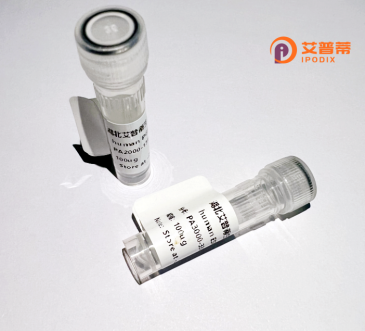
| 纯度 | >90%SDS-PAGE. |
| 种属 | Human |
| 靶点 | ARMETL1 |
| Uniprot No | Q49AH0 |
| 内毒素 | < 0.01EU/μg |
| 表达宿主 | E.coli |
| 表达区间 | 25-187aa |
| 氨基酸序列 | QGQEAG GRPGADCEVC KEFLNRFYKS LIDRGVNFSL DTIEKELISF CLDTKGKENR LCYYLGATKD AATKILSEVT RPMSVHMPAM KICEKLKKLD SQICELKYEK TLDLASVDLR KMRVAELKQI LHSWGEECRA CAEKTDYVNL IQELAPKYAA THPKTEL |
| 分子量 | 20 kDa |
| 蛋白标签 | His tag N-Terminus |
| 缓冲液 | 冻干粉 |
| 稳定性 & 储存条件 | Lyophilized protein should be stored at ≤ -20°C, stable for one year after receipt. Reconstituted protein solution can be stored at 2-8°C for 2-7 days. Aliquots of reconstituted samples are stable at ≤ -20°C for 3 months. |
| 复溶 | Always centrifuge tubes before opening.Do not mix by vortex or pipetting. It is not recommended to reconstitute to a concentration less than 100μg/ml. Dissolve the lyophilized protein in distilled water. Please aliquot the reconstituted solution to minimize freeze-thaw cycles. |
以下是3篇关于重组人ARMET(ARMETL1/MANF)蛋白的相关文献概览:
---
1. **文献名称**: *MANF: A New Mesencephalic, Astrocyte-Derived Neurotrophic Factor with Selectivity for Dopaminergic Neurons*
**作者**: Petrova P. et al. (2003)
**摘要**: 首次鉴定MANF蛋白(ARMETL1)在帕金森病模型中对多巴胺能神经元的保护作用,发现其通过抑制内质网应激通路减轻神经元凋亡。
---
2. **文献名称**: *Structural and Functional Analysis of the Conserved Domains of MANF/ARMET Protein Family*
**作者**: Lindahl M. et al. (2014)
**摘要**: 解析ARMETL1蛋白的三维结构,揭示其C端结构域在内质网应激响应中的关键作用,并通过重组蛋白实验验证其抗氧化和细胞保护功能。
---
3. **文献名称**: *Recombinant MANF Protein Alleviates Diabetic Retinopathy via Inhibiting Inflammatory Microglial Activation*
**作者**: Chen Y. et al. (2020)
**摘要**: 研究重组MANF蛋白在糖尿病视网膜病变模型中的疗效,发现其通过调控小胶质细胞炎症反应改善视网膜神经退行性病变。
---
**说明**:ARMETL1(Armadillo Repeat-containing Protein 1)也被称为MANF(Mesencephalic Astrocyte-derived Neurotrophic Factor),现有研究聚焦于其在神经保护、内质网应激调节及代谢性疾病治疗中的潜力。以上文献覆盖了基础机制、结构解析及疾病应用三个方向。
ARMETL1 (Arg/Abr-related gene-encoded Met-thionein-like protein 1), also known as MGC4509 or ARP, is a stress-inducible protein primarily localized in the endoplasmic reticulum (ER). Initially identified as a neuroprotective factor in unfolded protein response (UPR), it plays dual roles in ER stress regulation and extracellular signaling. The protein is encoded by the ARMETL1 gene in humans, located on chromosome 4q25. and shares structural homology with the ARMET protein family through its conserved N-terminal domain, though lacking enzymatic activity.
Biologically, ARMETL1 is upregulated under ER stress conditions, interacting with GRP78/BiP to modulate UPR pathways. Emerging evidence suggests its involvement in angiogenesis, cell proliferation, and tumor progression, with elevated expression observed in various cancers. Its secreted form, released via non-classical pathways, may function as a paracrine/autocrine signaling molecule in tissue repair and inflammation.
Recombinant ARMETL1 protein, typically produced in E. coli or mammalian expression systems, retains native folding and bioactivity. It serves as a critical tool for studying ER stress mechanisms, cancer biology, and potential therapeutic applications, including neuroprotection and anti-angiogenic therapies. Current research focuses on elucidating its receptor interactions and regulatory roles in pathological conditions.
×